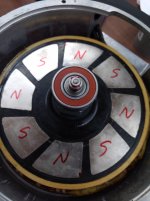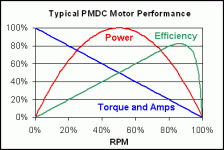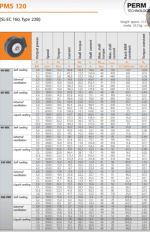So I'll apologize in advance for the long post with lots of questions...
Sorry.
I'm running a Heinzmann PMS126 axial flux motor in my Electrathon car.
It operates on 36v due to my battery weight restrictions although the controller (an ACD 4805) can supposedly handle up to 60v and according to the spec sheet the motor operates from 48v-560v (crazy).
So I'm undervolting a bit.
I built a hydraulic load cell a few years ago for motor testing and although it is not a dyno (putting out hp numbers) it does allow me to determine if a change I've made in voltage, timing, or controller settings, etc. helps or hurts efficiency by reproducing pump speed and output pressure and comparing wattage usage figures.
I generally test at a speed and pressure that equates to about 1/4 of the max of what it sees in competition.
I decided to peek under the hood of the motor after 3 years of running it stock and was surprised to see the left and right air gaps were uneven. .035" on one side and .055" on the other. Since everything I've read says that with air gaps "less is more" I decided to even them up and set them both at .025". I then ran it on my load tester and compared it to a baseline test performed before I reshimmed expecting to see an efficiency improvement.
Instead I saw an INCREASE in power usage of approximately 8%.
Confused, but willing to follow the numbers, I reshimmed again setting the air gaps to .070" and ran it again.
This time I saw an efficiency improvement over the stock setup of about 6%.
So what happened here?
My thoughts are that since the motor is designed to operate at a higher voltage than it does currently, that the flux created by the stator windings on 36v isn't sufficient to fully overcome the attraction of the rotor magnets to the stator laminations at such a narrow air gap.
Kinda like how you can get two opposing magnets to stick to the same piece of metal after you overcome the initial repulsion.
By increasing the air gap, I have moved the rotor far enough from the stator for the windings to be able to repel the rotor magnets more efficiently.
Is that right?
Another thing is the shape of the magnets in the rotor is not symmetrical.
I assume it has something to do with reducing cogging torque but perhaps not.
Anyway, does this mean that the motor should be more efficient in one direction vs the other?
And lastly...
I've always heard that motors are more efficient at higher voltages rather than lower ones as it reduces the resistance losses (or something).
So I decided to test my stock motor (pre-re-shimming) at 36v, 48v and 60v.
Oddly, the wattage requirement actually went up slightly with voltage. About 5% for each voltage jump at 1/4 max load.
Is this a function of the controller being less efficient while switching higher voltages or something else?
Racing Electrathon means always looking for more efficiency...
Thanks for your time.

Sorry.
I'm running a Heinzmann PMS126 axial flux motor in my Electrathon car.
It operates on 36v due to my battery weight restrictions although the controller (an ACD 4805) can supposedly handle up to 60v and according to the spec sheet the motor operates from 48v-560v (crazy).
So I'm undervolting a bit.
I built a hydraulic load cell a few years ago for motor testing and although it is not a dyno (putting out hp numbers) it does allow me to determine if a change I've made in voltage, timing, or controller settings, etc. helps or hurts efficiency by reproducing pump speed and output pressure and comparing wattage usage figures.
I generally test at a speed and pressure that equates to about 1/4 of the max of what it sees in competition.
I decided to peek under the hood of the motor after 3 years of running it stock and was surprised to see the left and right air gaps were uneven. .035" on one side and .055" on the other. Since everything I've read says that with air gaps "less is more" I decided to even them up and set them both at .025". I then ran it on my load tester and compared it to a baseline test performed before I reshimmed expecting to see an efficiency improvement.
Instead I saw an INCREASE in power usage of approximately 8%.
Confused, but willing to follow the numbers, I reshimmed again setting the air gaps to .070" and ran it again.
This time I saw an efficiency improvement over the stock setup of about 6%.
So what happened here?
My thoughts are that since the motor is designed to operate at a higher voltage than it does currently, that the flux created by the stator windings on 36v isn't sufficient to fully overcome the attraction of the rotor magnets to the stator laminations at such a narrow air gap.
Kinda like how you can get two opposing magnets to stick to the same piece of metal after you overcome the initial repulsion.
By increasing the air gap, I have moved the rotor far enough from the stator for the windings to be able to repel the rotor magnets more efficiently.
Is that right?
Another thing is the shape of the magnets in the rotor is not symmetrical.
I assume it has something to do with reducing cogging torque but perhaps not.
Anyway, does this mean that the motor should be more efficient in one direction vs the other?
And lastly...
I've always heard that motors are more efficient at higher voltages rather than lower ones as it reduces the resistance losses (or something).
So I decided to test my stock motor (pre-re-shimming) at 36v, 48v and 60v.
Oddly, the wattage requirement actually went up slightly with voltage. About 5% for each voltage jump at 1/4 max load.
Is this a function of the controller being less efficient while switching higher voltages or something else?
Racing Electrathon means always looking for more efficiency...
Thanks for your time.





